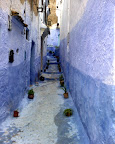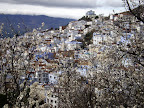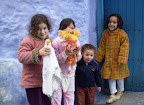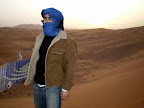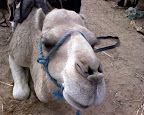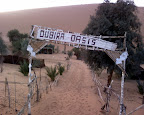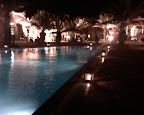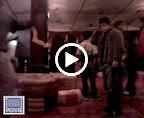Food, sights, sounds, smells, annoying people, crazy people, transvestites, crooks, and last, but not least, ass-grabbers.
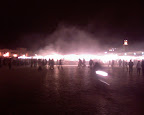 The food: Sheep heads and brains, snails, liver 'pate,' cow udders, and orange juice--lots and lots of orange juice. Marrakech is known for a braised lamb dish called Tanjiya. Instead of being cooked for hours in a conical tagine over coals (begin gripe: while the best of the tagines are cooked this way, I'll be damned if I've seen it done traditionally more than once or twice in Morocco--the fancy restaurants tend to cook everything in aluminum pots and just transfer into a tagine when ordered end gripe), this dish is
The food: Sheep heads and brains, snails, liver 'pate,' cow udders, and orange juice--lots and lots of orange juice. Marrakech is known for a braised lamb dish called Tanjiya. Instead of being cooked for hours in a conical tagine over coals (begin gripe: while the best of the tagines are cooked this way, I'll be damned if I've seen it done traditionally more than once or twice in Morocco--the fancy restaurants tend to cook everything in aluminum pots and just transfer into a tagine when ordered end gripe), this dish is  cooked in a curvy (think hips) ceramic pot for hours in the furnace of a hammam (traditional Roman/Moroccan sauna/bath). Spiced predominately with cumin, and usually prepared with mutton, it's a sure bet wherever you can find it.
cooked in a curvy (think hips) ceramic pot for hours in the furnace of a hammam (traditional Roman/Moroccan sauna/bath). Spiced predominately with cumin, and usually prepared with mutton, it's a sure bet wherever you can find it.
Really, though, the big thing in this town (for this insatiable cook, anyway) is the array of evening food stands in the main square of Djemaa el Fna. The fun starts toward dusk at 5 or 6pm and goes on until midnight. There are five snail stands, where snails are cooked just as I found them in Fez. Moving on, a few different guys have smoky grills putting up little white merguez (lamb) sausages and liver 'pate': a spiced (mostly cumin, garlic, paprika, and harissa) mix of beef liver and fat, very much resembling blood sausage. And then there're the offal guys. Lined up with sheep heads, cow udders, and beef tongues, these guys don't cater to the tourists (in fact, this whole scene, though indeed a draw for tourists, is really still largely a local thing). I'll get some more photos when I visit again, but in the meantime, my album has a couple of fun sheep head videos. Though I could go on and on about the food, suffice it to say that I ate until I, and those around me, dropped (case in point when Gabe and his dad joined in on the fun: we started with a steamed lamb brain, a bit of cow udder, some calf's tongue, and half a sheep head, and went from there...).
Sights, sounds, and smells; annoying people, crazy people, and transvestites; crooks and ass-grabbers: Needless to say, Marrakech has its share of each. Djemaa el Fna is surprisingly clean and odor-free in the morning, as the food stands disappear in the middle of the night after a big clean-up. Mornings in the square involve truckloads of oranges--no fewer than 15 carts selling fresh-squeezed juice call out to passers-by in the hopes of selling a three dirham (40 cents) glass of the stuff. The snake charmers accost unsuspecting tourists, wrapping a snake around your head and urging your friends to take pictures before demanding hefty payment (both of you and the picture-taker) for the privilege. By night, henna artists and fortune tellers surround the square and prey on tourists and locals alike. Men in veils belly dance (for such a conservative country, this is shocking, really) and lunatics surrounded by hordes of locals tell their tales--good old-fashioned story-telling: now why doesn't anybody do this at the county fair back home?
Walking through the souks can be just as daunting as it is in Fez. We walked around with no plans, just for the sake of walking, and ended up in some spots devoid of tourists. At one point Lora had her ass grabbed by a local guy who looked back at us with the cavalier look of a toreador before disappearing into the crowd.
On my last day there, we went to see the old Jewish quarter (the Jews weren't allowed to live amongst the Muslim folks, and so were segregated into the walled Mellach--every town has one) and cemetery. A young English-speaking local smelled Americans and offered his illicit services as our guide (the tourist office was closed, so we couldn't get an official guide). After showing us around for a bit and taking us to his family's overpriced ("I give you special price") spice shop, he unsurprisingly demanded an astronomical fee that not even the most jaded of us had anticipated. Lesson learned: better not to feed the pigeons, but if you're insistent on employing an illegal guide, negotiate before-hand. We paid the crook a fraction of his demands, and upon being followed and badgered, we gave him a couple American quarters and told him they were worth $4. He let up enough for us to make our getaway, probably cursing us Jews for ripping him off.
Most ridiculous run-in: The night that Lora left for Casablanca, by far. A lack of late-night trains meant that getting to the airport for her 8am flight would require at least some modicum of sketchiness, and more than likely a chunk of change. Bus travel was agreed upon as the next-best choice. Little did we expect the crowd drawn to the bus and terminal alike. Wow. I felt really, really bad, letting her go alone on this middle-of-the-night bus with a bunch of freaky guys. The kicker was when the bus finally showed up and the driver opened the cargo door on the side, waking up the man laying down there under blankets(!!!). Lesson learned (this one should have been common sense): bus travel with anyone other than CTM (the national bus service) is to be avoided in general, but most definitely by lone women in the middle of the night. Left with no choice, she boarded. An amazingly generous young man seated near her would later take her under his wing through the sketchiness in the Casablanca bus station and deliver her to the train station at 4am--no small miracle.

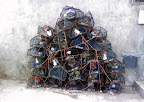
 The food:
The food: 